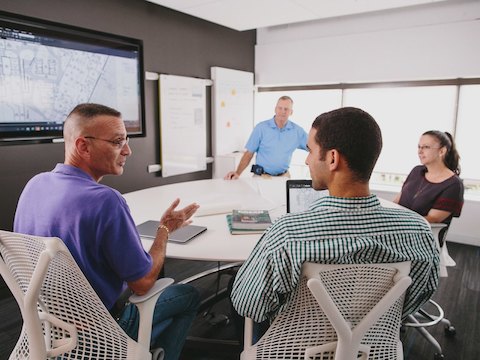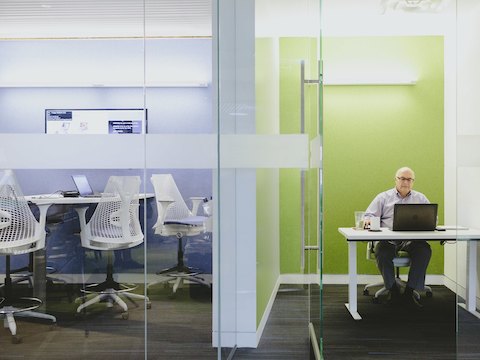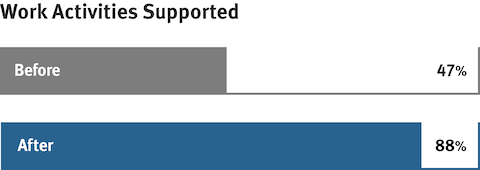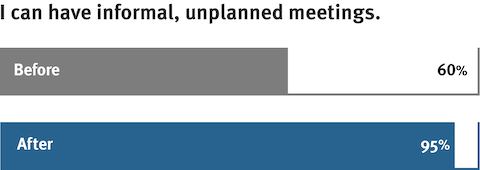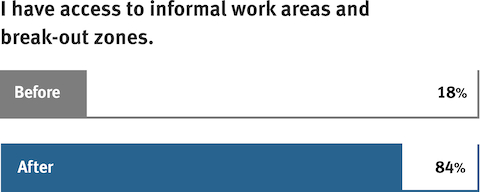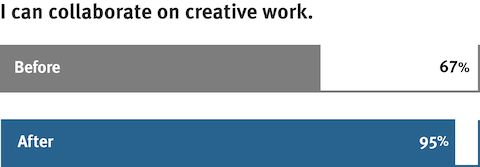Can Office Design Boost Innovation?
DPR Construction Case Study
Reston, Virginia, US
Download PDF (1.2 MB)
The temperature is pushing 100 degrees Fahrenheit as Randy Shumaker, a general superintendent for DPR Construction, tours the firm’s latest building site. A haze of sun and clouds blanket the towering steelscape; glistening I-beams spike right angles into the impressionistic sky.
This soon-to-be manufacturing facility is just one example of the company’s industry-leading, technology-based building approach—an approach that inspires many to join the DPR team.
“Buildings basically go together the same way they did 40 years ago,” says Shumaker. “The nuts and bolts are the same, but what’s different is the technology. I wanted to learn something new, and the innovation really drew me to DPR.”
DPR’s innovative building methods have improved efficiencies in how the company plans and constructs highly complex structures built to rigorous standards for safety, technology, and sustainability. When the time came for DPR to move to a new office in Reston, Virginia, the DPR team was excited to create a workplace that would showcase their building expertise. The new facility would be a better reflection of the company’s empowering and collaborative culture and would encourage the inter-generational exchange of ideas that helps fuel DPR’s creative engines.
“Part of what we need to do is grow the younger generation so they understand the intricacies of a build,” says Shumaker. “They, in turn, share new ideas they’ve learned. This makes us a stronger team, which makes us a better company.”
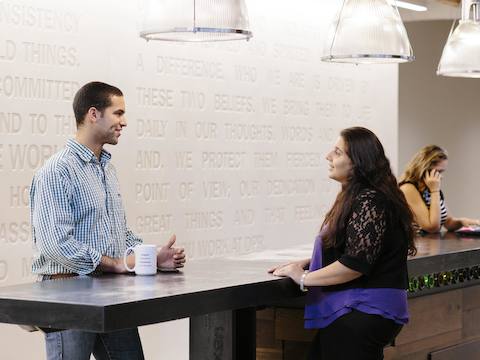
Opportunities for informal interactions abound throughout DPR’s new office. People from all parts of the company bump into one another when they take breaks in the Plaza.
Making Place for Innovation
Before moving to Reston, DPR was challenged with an office that was beginning to inhibit the person-to-person connection that’s essential to the company’s success. “For us, innovation is about collaboration—working together to come up with new ways to solve old problems,” says Chris Gorthy, a project executive with DPR. “When we started struggling to do that in our old office, we knew it was time for a change.”
Even though DPR’s current office allotted ample space for individual workstations, DPR employees described the space as “overbooked” and “isolating.” With no communal areas for socializing and a scarcity of conference rooms, many people chose to work at their jobsites instead of coming into the office.
As the DPR team sought a new work environment, Greg Haldeman, a member of DPR’s management committee, says they embraced the opportunity to create a more collaborative workplace that better reflects who they are and what they do. The project team identified several goals, including the following two: to create an office that would showcase their sustainable building expertise, and to design a living lab where they could test and measure workplace strategies that would encourage people to share knowledge and solve problems creatively.
To achieve the first goal, the DPR team decided to reuse a facility in Reston, Virginia. “We wanted to demonstrate that you could reuse a building and still achieve Net Zero Energy Building Certification, even in a building that’s 35 years old and in a challenging climate zone. It would be a first for the D.C. Metro area,” says Chris Hoffman, a project manager with DPR. After building three other DPR offices that have been Net Zero certified, the team had a wealth of data and insight to inform the project. Sustainability, however, was only the beginning.
DPR wanted to create an office environment that set new standards for the future of workplace design. For help reaching this goal and translating the company’s progressive approach to construction into workplace design, DPR turned to Herman Miller and its research-based Living Office approach.
During DPR’s time at Herman Miller, specialists guided the team through the Living Office Discovery Process. This workshop gave DPR and its design partner, SmithGroupJJR, the tools they needed to identify and rally around the company’s purpose, character, and activities.
Gorthy was surprised to learn that this approach was about far more than furniture when he visited Herman Miller’s West Michigan headquarters. “I thought that the trip was going to be more about selling us on furniture, but what it did was sell us on placemaking and what the workplace could be,” he says. “Herman Miller helped us think about the verb versus the noun of each space—thinking about what people do and designing the environment around that.”
For DPR, the verb that came up most during the Discovery Process was collaborate. The mix of contractors, architects, engineers, and project managers working in the office and out in the field needed a variety of settings where they could easily connect and catch up on projects. To accommodate the nuances of these encounters, a handful of standard conference rooms simply wouldn’t do.
“The visit to Herman Miller helped DPR prioritize what they felt was important,” says Marc Schneiderman, design principal with SmithGroupJJR. “Seeing the furniture and settings throughout the office gave them visual clues about how their workplace could have a more flexible floorplan.”
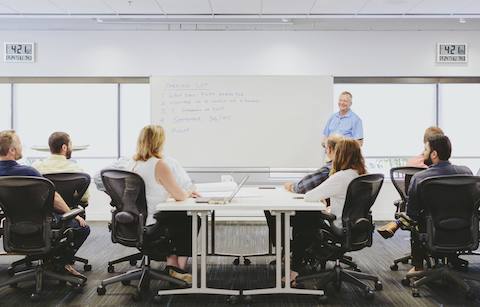
This flexible Forum Setting brings people from all parts of the company together with furnishings and tools that stimulate idea sharing.
Primed for Interaction
Through the Living Office Discovery Process, DPR and SmithGroupJJR gained new research-based insights into the team’s interactive style of working—insights that helped the team determine the right balance of settings the company would need to be successful. From Meeting Spaces and Workshops for group activities to Hives and Havens for individual tasks, Living Office gave the design team a framework of 10 settings optimized for work and interaction. It also provided a means for evaluating how the workplace was performing after the team moved in.
“DPR didn’t just resuscitate a dilapidated building,” says Schneiderman. “They injected it with a new persona.” This sparkling new personality goes beyond attractive furniture, bright colors, and lush plants to a workplace with a serious purpose. Everything from the kitchen to the connective space to a variety of group settings is primed to sustain DPR’s collaborative culture.
“From a workplace standpoint, we’ve created lots of activity zones for people,” says Gorthy. “We took an open office culture and combined it with a world-class space that allows people to connect.”
Very intentionally, the new office landscape presents opportunities for interactions of all types to happen. But the interactions that DPR values most are the ones you can’t predict.
“Herman Miller talked to us about how you can engineer impromptu conversations, which is something I never thought about,” says Jodi Paci, a business development manager at DPR. “If all you have is conference rooms and no places to chat, it’s not going to be as successful. The impromptu conversations don’t just happen. You need to have settings that encourage them.”
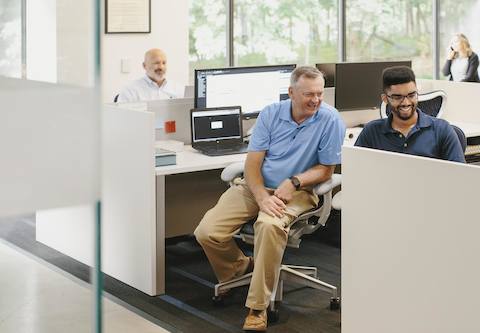
The open, flexible layout of the new office makes it easy for people to take a time out from their individual tasks to chat, ask questions, or share ideas.
Beyond the main workspace, a long, open corridor lined with glass-walled Meetings Spaces, Workshops, and Havens gives people a choice of settings where they can review projects, brainstorm, have quiet conversations, or focus on individual tasks.
“We had three conference rooms in the old building,” says Shumaker. “Here we have 10–12 different Meeting Spaces to choose from, and you can choose a room that suits the sort of interaction you want to have. If employees get stuck on a problem, they feel more comfortable using the new environment to start brainstorming and have conversations.”
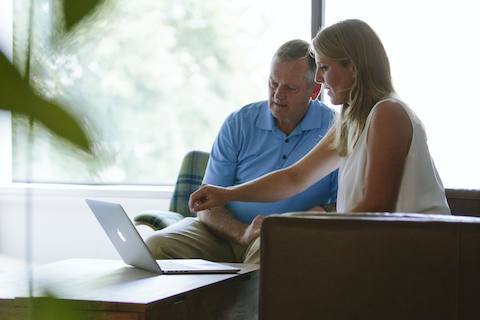
Contractors, site superintendents, and other employees who are frequently out in the field now have a variety of settings where they can meet and give each other project updates.
A wine bar serves as a Landing Setting just outside DPR’s large Forum, which doubles as a favorite spot for large corporate gatherings and a training room for employees. Here, people vacillate between meeting and socializing over drinks or snacks at the bar.
“Now we host national-level meetings, which we couldn’t facilitate in our previous office,” says Chris Gorthy. “We can bring in experts from around the company who interact with our employees. People are sharing stories and information, and that knowledge transfer is helping us connect the dots and solve problems.”
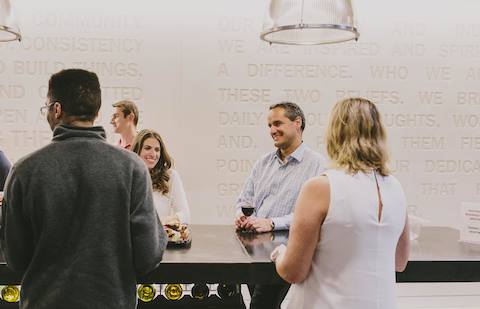
In the centrally located Plaza Setting, people enjoy the more social side of work. At ease with one another, people share their ideas and have the confidence to help others shape theirs.
The Results Are In
“What’s unique about DPR is that they have a very cohesive and collaborative culture,” says Schneiderman. “That wasn’t evident in the previous facility. The layout didn’t have a logic about how their daily sequence of activities happened. The new workplace is a paradigm shift for them. It flows with the way they work.”
Quantitative evidence from third party research proves that this shift is enhancing performance for both people and the organization. Herman Miller conducted a Leesman Survey for Workplace Effectiveness both before and after the move to the new office. Positive results place DPR in the top tier of high-performing companies for 2017.
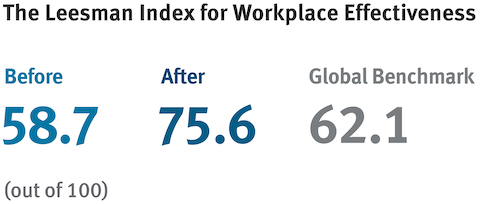
Leesman is a global benchmarking service that gathers and analyzes data on workplace effectiveness from thousands of organizations. DPR’s excellent score earned them a Leesman+ accreditation—an achievement reached by only six percent of participating organizations—and put them in the top ten of Leesman’s high performers for 2017.
DPR is also measuring its workplace against standards from the International WELL Building Institute, which advances health and well-being in buildings globally. Among several other categories, DPR has excellent scores for design considerations that provide physical and mental comfort, including sit-to-stand desks and settings that offer quiet and privacy.
With WELL measuring the effectiveness of the facility and Leesman measuring employees’ enthusiastic response to it, Gorthy believes DPR’s workplace is helping their people carry out the organization’s purpose. “Our investment in this new environment was for our people, but it’s also allowing us to leverage our office to educate others. We can share what we’ve done here—how we’re showing respect for individuals and the environment—and make a broader impact on society.”
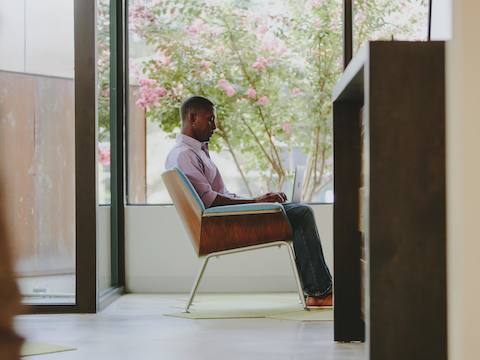
By creating a workplace that cares for people’s physical and emotional needs, DPR built a showcase for the sustainable and health-positive building principles it promotes to clients.
